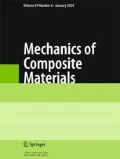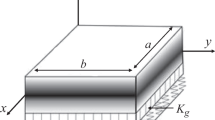Abstract
The main stages of development of the stability theory of sandwich structural elements are considered. The mechanism of their stability loss is revealed using the experimental data and theoretical solutions obtained on the basis of refined statements of problems. A classification of all possible forms of stability loss is given within the limits of continuum representation of load-bearing layers and the core of these structures.
Similar content being viewed by others
References
A. K. Noor, W. S. Durton, and C. W. Bert, “Computational modes for sandwich panels and shells,” Appl. Mech. Rev.,49, No. 3, 155–199 (1996).
E. Reissner, “Finite deflections of sandwich plates,” J. Aeronaut. Sci.,15, No. 7, 435–440 (1948).
E. I. Grigolyuk, “Equations of sandwich shells with a light filler,” Izv. Akad. Nauk SSSR. Otd. Tekhn. Nauk, No. 1, 77–84 (1957).
E. I. Grigolyuk, “Finite deflections of sandwich shells with a rigid filler,” Izv. Akad. Nauk SSSR. Otd. Tekh. Nauk, No. 1, 26–34 (1958).
V. V. Bolotin, “On the theory of layered plates,” Izv. Akad. Nauk SSSR. Otd. Tekh. Nauk., Mekh. Mashinostr., No. 3, 65–72 (1963).
V. V. Bolotin and Yu. N. Novichkov, Mechanics of Multilayered Structures [in Russian], Mashinostroenie, Moscow (1980).
V. N. Kobelev, L. M. Kovarskii, and S. I. Timofeev, Calculation of Sandwich Structures [in Russian], Mashinostroenie, Moscow (1984).
A. Ya. Aleksandrov, L. E. Bryukker, L. M. Kurshin, and A. P. Prusakov, Design of Three-Layer Panels [in Russian], Oboronizd., Moscow (1960).
A. Ya. Aleksandrov and E. P. Trofimova, “Comparison of calculation and test results in longitudinal compression of sandwich plates with a honeycomb filler,” in: Calculation of Elements of Aircraft Structures [in Russian], Mashinostroenie, Moscow (1965), pp. 59–73.
A. I. Endogur, N. V. Vainberg, and K. M. Ierusalimskii, Honeycomb Structures. Choice of Parameters and Design [in Russian], Mashinostroenie, Moscow (1986).
V. N. Paimushin and N. K. Galimov, “Stability of three-layered plates with a light filler upon flexure,” in: Proc. Sem. on Shell Theory, No. 5, Kazan. Fiz-Tekhn. Inst. Akad. Nauk SSSR, Kazan' (1974).
V. N. Paimushin, N. K. Galimov, and V. F. Snigirev, “Axisymmetric bending and stability of round sandwich plates with a light filler under combined loading,” in: Investigations of Nonlinear Problems of the Theory of Plates and Shells, Saratov. Univ., Saratov (1974), pp. 94–102.
V. N. Paimushin and S. N. Bobrov, “Forms of stability loss of three-layer plates and shells with external layers made of homogeneous or reinforced materials,” Mech. Compos. Mater.,21, No. 1, 64–69 (1985).
V. N. Paimushin and S. N. Bobrov, “Stability of an indefinitely wide three-layer plate upon axial compression of one layer,” Mech. Compos. Mater.,21, No. 2, 194–200 (1985).
V. N. Paimushin, “Refined nonlinear theory of middle bending of sandwich shells with a transversely soft filler under the action of thermal forces,” Izv. Vuzov., Aviats. Tekhn., No. 4, 8–12 (1989).
V. A. Ivanov and V. N. Paimushin, “Refined theory of stability of three-layered structures (nonlinear equations of precritical equilibrium in shells with a transversely soft filler),” Izv. Vyssh. Uchebn. Zaved., Matematika, No. 11, 29–42 (1994).
V. A. Ivanov, V. N. Paimushin, and T. V. Polyakova, “Refined theory of stability of three-layered structures (linearized equations of neutral equilibrium and elementary one-dimensional problems),” Izv. Vyssh. Uchebn. Zaved., Matematika, No. 3, 15–24 (1995).
Yu. V. Orlov, V. N. Paimushin, and T. V. Polyakova, “Refined statement of stability problems of the moment equilibrium for rotational sandwich shells with a transversely soft filler,” in: Proc. XVI Int. Conf. Theory of Shells and Plates, 1, Nizhnii Novgorod, (1994), pp. 167–176.
A. I. Golovanov and V. N. Paimushin, “Stress-strain state and stability of composite sandwich shells with a scaling zone between the core and facings,” Mech. Compos. Mater.,29, No. 5, 473–484 (1993).
A. I. Golovanov, V. A. Ivanov, and V. N. Paimushin, “Numerical analysis method for studying local forms of stability loss of bearing layers of three-layered shells using the mixed forms,” Mech. Compos. Mater.,31, No. 1, 69–79 (1995).
M. K. Galimov, V. A. Ivanov, and V. N. Paimushin, “Stability problem of the moment equilibrium of three-layered plates and shells and modeling of a core in the perturbed state,” in: Proc. XVII Int. Conf. Theory of Plates and Shells, 1, Kazan', (1996), pp. 16–23.
Additional information
Center for Study of Dynamics and Stability, Tupolev Kazan State Technical University, Kazan, Tatarstan, Russia. Translated from Mekhanika Kompozitnykh Materialov, Vol. 35, No. 6, pp. 707–716, November–December, 1999.
Rights and permissions
About this article
Cite this article
Paimushin, V.N. A stability theory of sandwich structural elements 1. Analysis of the current state and a refined classification of buckling forms. Mech Compos Mater 35, 465–470 (1999). https://doi.org/10.1007/BF02259468
Received:
Issue Date:
DOI: https://doi.org/10.1007/BF02259468



